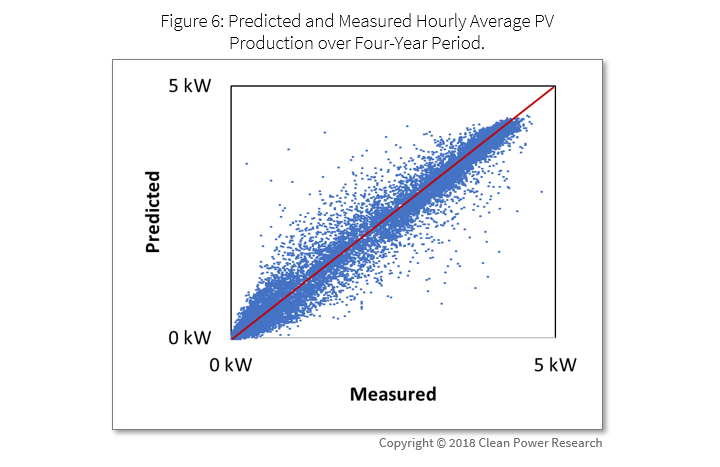This article is a follow-on to Clean Power Research’s 11-part series on Solar+ homes series. Solar+ homes describes how homeowners can combine simple energy efficiency measures, solar PV, electric vehicles (EVs) and appliance electrification to create households that are fully powered by solar electricity—even in existing homes. A Solar+ home provides substantial economic and environmental savings to the homeowner and creates load profiles that are low-cost for utilities to serve.
Solar+ home: the first four years
In June 2018, Clean Power Research reached a milestone when our prototype Solar+ home reached four years of operation. This blog discusses how this home is helping to prove out the Solar+ homes approach—and the benefits to both consumers and utilities.
What is a Solar+ home?
Households consume gasoline, natural gas (or another heating fuel) and electricity for automobile transportation, space heating and cooling, water heating, baseloads and other non-Heating Ventilation and Air Conditioning (HVAC) loads.
There is a growing interest in applying a zero net energy approach to new homes. There is also a growing interest in electrifying transportation. In previous blogs and whitepapers, we referred to the zero net energy approach plus transportation when applied to a residential home—new or existing—as the Solar+ home.
Research Project
We designed a research project in early 2014 to answer two questions:
- Is it feasible to convert an existing home to a Solar+ home without major home reconstruction?
- Is it feasible to size and install a PV system that accurately anticipates future electricity needs?
As described in previous work, a Solar + home:
- Fuel switches to electric technologies and applies other efficiency measures
- Supplies electricity using solar power
- Matches electricity supply to demand
When we applied these principles to an existing home, the outcome was extraordinary:
- Lowered utility and gasoline bills
- Reduced carbon emissions
- Increased home comfort
- Reduced operating costs for utilities
- Satisfaction of supporting environmental goals for society
Size PV system
Energy efficiency experts recommend that building owners implement efficiency first and then install solar based on the reduced load. We wanted to prove that one could reverse the order and install the PV system early in the process by properly predicting future loads and forecasting PV system production.
One of the first steps we took to create a Solar+ home was to size and install a PV system to meet all anticipated future annual consumption. We did this before making all other energy investments. To determine future load, we converted gallons of gas (for personal transportation) and therms of natural gas (for space heating and water heating) to the equivalent site energy in kWh and added the results to electricity usage.
As shown in Figure 1, the home consumed the equivalent of 45,000 kWh of site energy per year prior to any investments. We predicted that the home could reduce usage to 8,000 kWh by fuel switching to electric technologies and applying other efficiency measures. We predicted that a 6 kWDC PV system would satisfy all annual consumption.
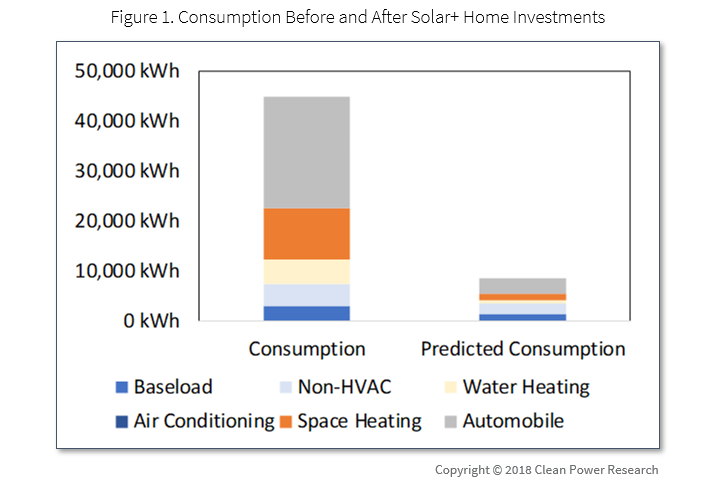 Install technologies
Install technologies
We implemented the following investments in the following order in our prototype home:
- Switched one gas-powered vehicle to an electric vehicle and another to a hybrid electric vehicle
- Reduced electric baseloads and install LED lights
- Installed a PV system
- Switched to a heat pump water heater from a natural gas water heater
- Switched to a mini-split heat pump space heater from a natural gas space heater
- Reduced unwanted building shell energy losses and gains. We did this by:
- Filling holes using caulking and spray foam insulation
- Re-attaching detached insulation
- Increasing attic insulation
- Insulating uninsulated parts of the home
- Installing thermal window shades
- Installing removable solar screens to block solar gain in the summer but allow solar gain in the winter
- Allowing for unobstructed passive air flow to keep the attic cool
- Shading the roof using the PV system
- Installed a whole house fan for night time ventilation in the summer
Solar+ home proven: One can convert an existing home
The first question was to determine if it’s feasible to convert an existing home to a Solar+ home without major home reconstruction. In particularly, we excluded the option of a “deep retrofit” because it involved major home reconstruction (and major costs). Instead, we took the approach of finding holes and thermal gaps in the home and eliminating them.
We collected detailed data on the home during the past four years. The home consumed 32,208 kWh and the PV system produced 31,670 kWh for a net consumption of 537 kWh from July 1, 2014 to June 30, 2018. As shown in Figure 2, the home met the consumption target of 8,000 kWh per year and the PV system was sized within 2 percent of annual consumption.
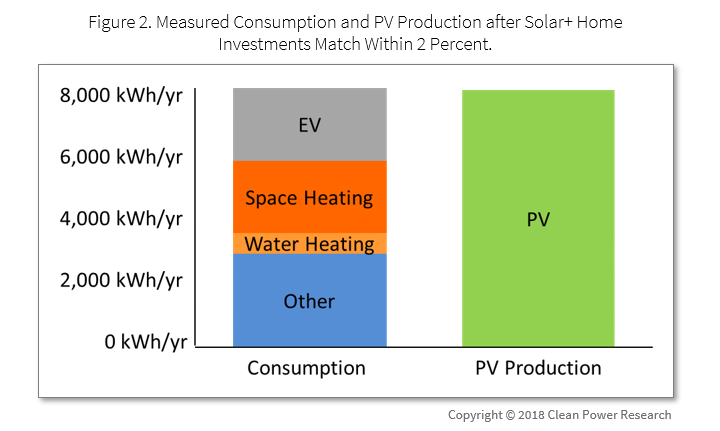
It’s also interesting to understand consumption by end-use. As shown in Figure 3, the project monitored power consumption on a dozen electrical circuits every second.
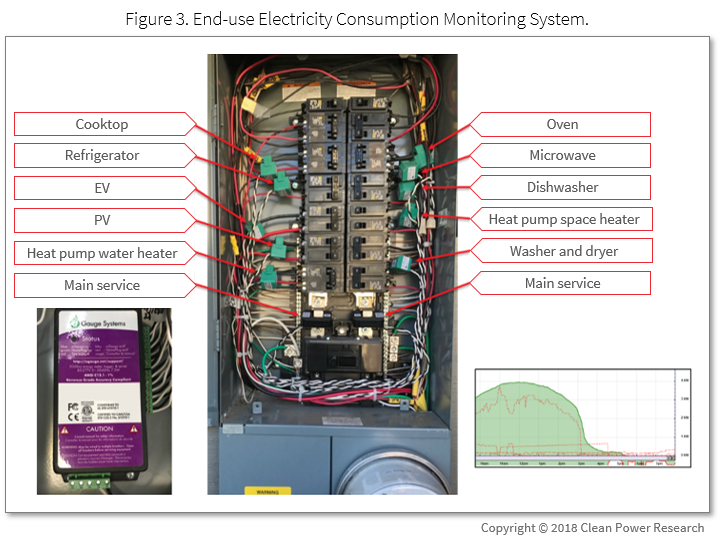
This produced a detailed dataset that provided additional insights. For example, we initially believed the home could become a Solar+ home by switching from a natural gas space heater to electric resistance heating. As shown in Figure 4 below, the first winter of operation (’14 – ’15) seemed to confirm this. Space heating consumption increased dramatically, however, in the second year. The home required a more efficient heating system (i.e., an electric mini-split heat pump) and some additional building shell investments. Consumption was less than PV production in the fourth year.
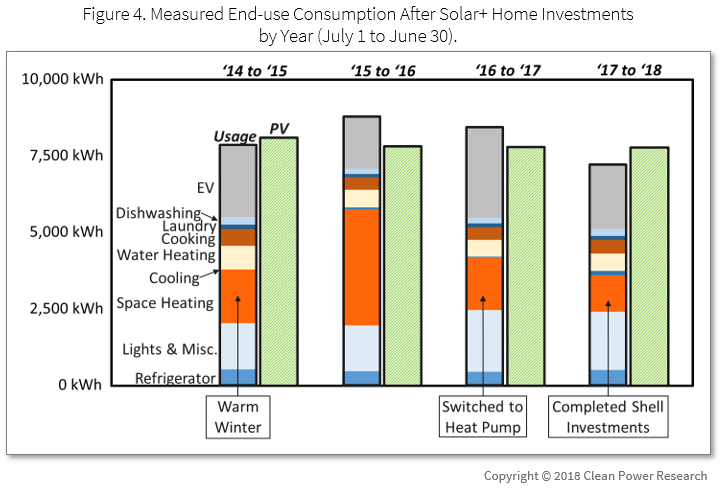 .
.
Proven: One can size a PV system to anticipate future electricity requirements
The second question was whether one could properly size the PV system in anticipation of future electricity requirements. This required correctly anticipating future loads and accurately forecasting PV production.
The first step was to estimate how switching to electric technologies and applying other efficiency measures would change electricity consumption. A particularly difficult part of the process was to estimate the change in heating energy consumption due to building shell and HVAC investments. We have subsequently developed the Virtual Energy Audit™ to assist in producing this estimate.
The second step was to size the PV system to satisfy the loads. SolarAnywhere® predicts how much energy a PV system will produce based on location and PV system characteristics. Based on the specifications for this system, SolarAnywhere predicted the system would produce 31,516 kWh from July 1, 2014 to June 30, 2018. Looking back at actual data, we know that it actually produced 31,700 kWh. That is, as shown in Figure 5, SolarAnywhere was only off by ½ percent.
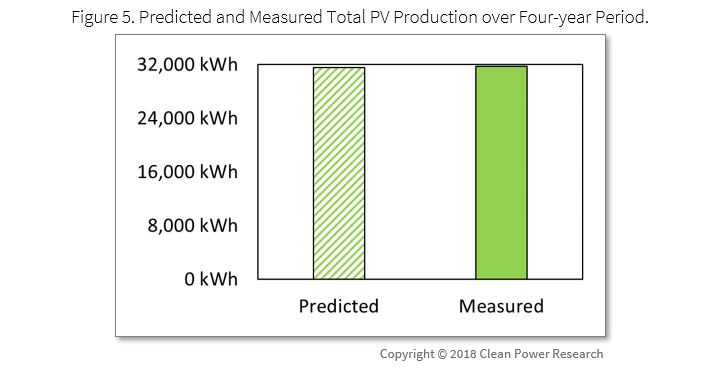
SolarAnywhere also excelled at the challenging task of predicting PV production for every hour in the four-year period as shown in Figure 6. An accurate representation of hourly PV production will become more important as electric rate structures change and there is a need to predict the timing of net loads.
Conclusions
The project provides an affirmative answer to the two questions posed above. First, one can convert an existing home to a Solar+ home without a deep retrofit. Second, one can size a PV system that accurately anticipates future electricity needs before they occur.
A variety of tools can assist in the process:
- SolarAnywhere can assist in estimating PV production
- WattPlan® can assist in evaluating specific investments
- The Virtual Energy Audit can assist in thermally characterizing the home.
These tools can help other home owners to transform their homes into Solar+ homes to benefit themselves, utilities, and society.

